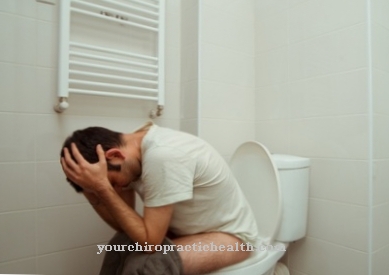A Testicular swelling occur in one or both testicles now and then in men. But they are not an independent disease, but a symptom that can have various causes. It is therefore important to diagnose the actual underlying disease for successful treatment.
What is testicular swelling?

Testicular swelling is an enlargement of one or both testicles. It can be painful or painless. The skin of the scrotum is stretched, it may be red and feel hot.
Fever also occasionally occurs. The swelling is caused by a build-up of fluid in the testicles or the epididymis. Since various diseases of the urological tract may be the cause, it is recommended that a doctor (usually a urologist) clarify this as quickly as possible.
causes
One of the most common causes of testicular swelling is testicular torsion, the technical term is testicular torsion. A testicle twist usually only affects one testicle, is painful and is considered an absolute emergency.
A water fracture or a hernia can also cause testicular swelling. Such a break can already be present at birth, but can also occur at a later age. Due to the inguinal canal, which is not completely closed, fluid collects in the scrotum and leads to a mostly painless swelling. The doctor speaks of a hernia in the case of an inguinal hernia and a hydrocele in the case of a water rupture.
Epididymitis is caused by bacteria or viruses traveling up the urethra. The inflammation of the testicles often occurs as a result of an infectious disease such as mumps, chickenpox or glandular fever. In very rare cases, a testicular tumor is the cause of the swelling. Testicular swelling and bruising can also occur after an accident testicle injury.
You can find your medication here
➔ Medicines for painDiseases with this symptom
- Epididymitis
- Testicular cancer
- mumps
- Water break
- disc prolapse
- Inguinal hernia
- Undescended testicles
- chickenpox
- Inflammation of the testicles
- Testicular torsion
- Acute scrotum
- Glandular Pfeiffer fever
Diagnosis & course
The doctor can usually make a thorough diagnosis very quickly. After a preliminary talk he will look at the testicle and feel it carefully. This palpation examination reveals whether it is testicular torsion or inflammation. If the testicle is inflamed, lifting the testicles will reduce the pain; if the testicle is twisted, the pain is increased by lifting it.
In the case of inflammation, the analysis of blood and urine in the laboratory supports the diagnosis. An ultrasound scan can help determine more details, such as whether inflammation has caused abscesses or a tumor. Testicular torsion is also clearly recognized in the ultrasound image. In most cases, subsequent treatment is necessary in order to positively influence the further course of the disease.
Complications
An example of the development of testicular swelling is the accumulation of fluid in the scrotum (hydrocele) due to an open connection between the testicle and the abdomen. Usually this is easily recognized and operated on. If left untreated, however, water can continue to accumulate and uncomfortable feelings of tension and pressure arise.
In addition, there is an increased likelihood of testicular torsion, i.e. the twisting of the testicle around itself. This cuts off the blood flow to the testicle and causes severe pain. This also affects the quality of the sperm and can lead to infertility.
In addition to testicular torsion, due to the open connection to the abdominal cavity, a loop of intestine can easily enter through the inguinal canal and thus cause an indirect hernia. In addition to water retention, inflammation of the testicle (orchitis) or the epididymis (epididymitis) can cause swelling.
If left untreated, serious complications can arise. Bacteria can get into the blood and trigger a systemic infection (sepsis). If left untreated, these are life-threatening and can lead to the death of the patient in 60 percent of cases.
Tumors or cysts also cause swelling in the testicle area. The complications that they entail differ depending on the size and type of the disease and, here too, primarily affect the patient's fertility.
When should you go to the doctor?
Testicular swelling that is both unilateral and bilateral is a symptom, not a disease. The question of whether or when someone with swollen testicles should go to the doctor has only one answer: Always and immediately! This also applies if there is no pain. The swelling of the testicles is always caused by a disease of the urological area. An early clarification with the urologist should be done as soon as possible in your own interest.
The cause of swelling of the testicles can be a hernia or a water fracture, which causes fluid to enter the scrotum and collect there. Clumsy movement can cause the testicle to bruise and swell. A bacterial or viral epididymis or the formation of an abscess is also conceivable.
Notorious are testicular inflammation caused by infectious diseases such as chickenpox, mumps or Pfeiffer's glandular fever, which even threaten infertility. In the event of a painful twisting of the testicles, the emergency doctor must be called immediately. A tumor as the cause of testicular swelling is rare, but cannot be ruled out. In the event of swelling of the testicles, no one should hesitate to go to the urologist out of exaggerated shame.
Doctors & therapists in your area
Treatment & Therapy
If the swelling of the testicles is caused by testicular torsion, the testicle rotates and thus constricts itself from the blood supply. This is why an operation is necessary within a few hours to prevent further damage and any subsequent inability to conceive. The surgeon will open the scrotum, return the testicle to its normal position, and hold it in place to prevent it from twisting again. If the operation is carried out on time, the testicle recovers within a short time and there are no consequential damages.
If there is inflammation, the testicle should be immobilized; cool compresses are also helpful. If the inflammation is viral, the doctor may prescribe anti-inflammatory and analgesic drugs. If there is a bacterial infection, antibiotics tailored to the pathogen are used. Acute testicular inflammation heals completely within a few weeks, only in exceptional cases does it turn into a chronic stage.
If a testicular tumor is diagnosed, surgery is performed, and in some cases radiation treatment or chemotherapy is followed. The prognosis for this type of cancer is very good, even at an advanced stage.
Inguinal hernias are not dangerous, but they too must be treated surgically. The doctor will only wait for a slight form of water breakage in infancy, as the inguinal canal can still close.
Outlook & forecast
Testicular swelling does not need to be treated in every case. It is not uncommon for the swelling to go away on its own. However, if this occurs over a longer period of time or if it leads to severe pain, a doctor must be consulted.
The swelling can have many different causes. It is not uncommon for this to be inflammation or the formation of abscesses. In the worst case, a tumor is responsible for the swelling of the testicles and the associated pain. A cure is usually possible with early treatment.
If the blood flow is restricted by the swelling of the testicles, it can lead to fertility problems, with the patient suffering from complete infertility in the worst case. An inguinal hernia can also occur, which is associated with swelling and severe pain. If left untreated, the swelling of the testicles can lead to an infection that can spread to the body.
The swelling of the testicles is treated causally, with surgery being necessary in most cases. Antibiotics can also be used for inflammation. Tumors are surgically removed, but there is no guarantee of complete healing.
You can find your medication here
➔ Medicines for painprevention
A healthy lifestyle is the best prevention, but if a cystitis does occur it should be treated immediately. Those who prefer high-risk sports with a risk of injury should not do without testicle protection. Vaccinations against mumps, measles and chickenpox can also prevent swelling of the testicles.
You can do that yourself
In the event of overheating, incorrect positioning of the scrotum and swelling, an occasional straightening of the genitals helps. These are brought into a comfortable position and the air circulation around the testicles is improved. Such an adjustment is recommended for long periods of sitting or poorly fitting legwear. If the swelling is painful, the diseased organ can be quickly raised. For on the go there is the so-called jockstrap, which supports the affected testicles.
Another helpful utensil is the so-called testicular bank. This is a small storage pillow. The scrotum is relieved by the high position. The swelling goes down. These two helpful items are available from the medical supply store. They can be easily integrated into everyday life if the testicles are swollen. In the phase of acute pain, tight-fitting underwear is helpful. Because in contrast to wide-cut underwear, it has a supporting function.
Wraps with tempered water cool the swollen testicles and relieve pain. Even a wet washcloth can help. Important: temperate to cool - under no circumstances ice cold! If the symptoms persist, you should refrain from further self-help and consult a doctor urgently.




.jpg)



.jpg)



















